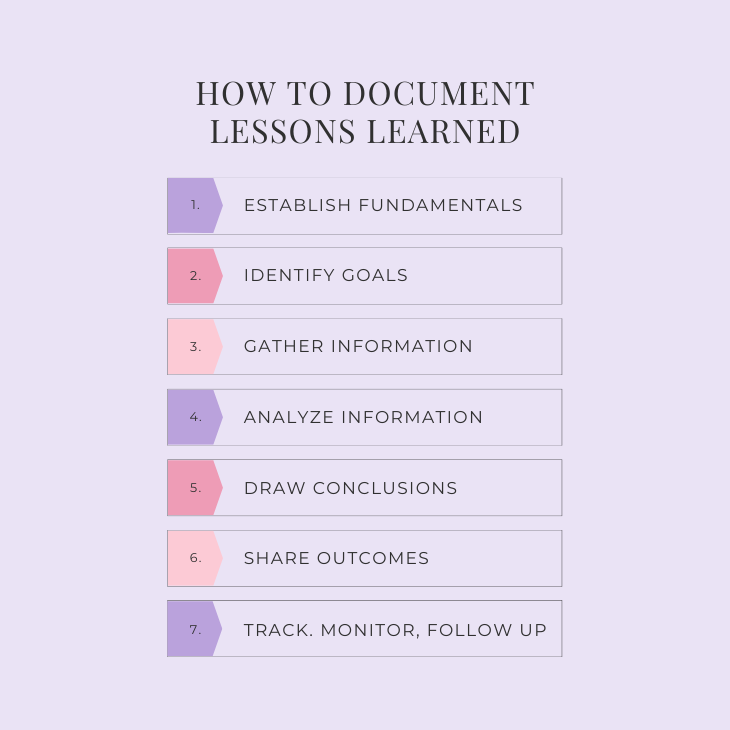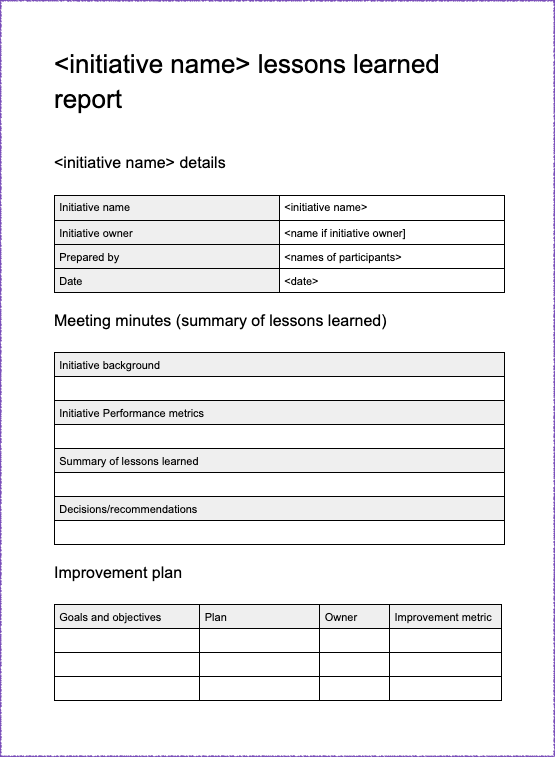They say practice makes perfect, you should learn from your mistakes and a donkey doesn’t bump against the same stone twice.

When I think about capturing and documenting actionable lessons learned in my job as a product manager, I’m often reminded of Wile E. Coyote and the Road Runner.
In the cartoon, Coyote repeatedly devises schemes to catch and eat the Road Runner. In the process, he often gets terribly and comically injured. Despite his efforts, only on rare occasions is Coyote able to catch the Road Runner, and he never manages to eat her.
As a kid, I remember shouting at the TV, trying to encourage Coyote to do better. Why doesn’t Coyote take a step back, review what worked well and what didn’t, and take stock of lessons learned? You’d think he’d be interested in learning from and improving on past mistakes so he could strive for a brighter future (in which Road Runner is on the menu for dinner).
The same applies to companies and product organizations. If you make mistakes without reviewing what went wrong, repeated mishaps could eventually result in huge revenue loss, reputational damage, and fines. Over and over again.
This stresses the importance of capturing and actioning lessons learned. In this guide, we’ll demonstrate how to take stock of your mistakes and, in doing so, facilitate the principle of continuous improvement that is central to agile methodologies.
Lessons learned are reflections on past experiences that help you avoid repeating mistakes and improve your processes and outcomes.
In product management, lessons learned are an essential tool for improving operations, gaining valuable insights, and making data-driven decisions.
More specifically, lessons learned enable you to:
Eager to get going? Let’s not rush it.
As with most practices, capturing actionable lessons learned is a process. Traditionally the process consists of five steps:
Personally, I’ve found that just following these five steps often results in lessons learned being stored, but not acted upon. This renders the whole effort an utter waste of time and resources.
Instead, I would suggesting using an expanded, seven-step process for documenting and generating actionable insights from lessons learned:
If you’d like to follow along and document as we walk through these seven steps, you can use our free lessons learned report template to help you get off the ground.

Before starting lessons learned, make sure the following two principles are in place:
If it’s the company’s first lessons learned, agree on how and where to capture lessons learned. That way, they can be accessed and followed up upon, their results can be monitored, and action can be taken when needed.
Adopt a consistent set of criteria to make the ranking understandable, aligned, and reusable companywide.
A tip for picking the criteria is to lay out all the factors you could potentially optimize for and decide which are must-haves. This could be fines, brand damage, investments, and so forth.
Identify what you want to capture the lessons learned for. This can be a project, event, ongoing delivery, or even a failed initiative.
Determine who to capture the lessons learned from. Who are your stakeholders? This can include both customers and internal stakeholders, such as operations, legal, sales, and customer success.
Once you’ve completed the identification part, gather information about what happened. Include successes, challenges, and any issues that arose.
The information can be acquired through interviews, surveys, workshops, analytics, and relevant documentation.
Once you’ve gathered all the valuable information, the next step is to analyze it. Identify patterns or common themes to establish takeaways and — you guessed it — lessons learned.
There is a good chance you will end up with a long list of takeaways. Use prioritization guidelines to rank and identify the key takeaways. This will help to focus on the most critical lessons that need to be addressed.
Sharing is caring. Be sure to communicate the lessons learned with all relevant stakeholders frequently and effectively. For example, you might create a presentation or host a meeting to share the outcomes.
Publish the information in the companywide agreed location and format, for future reference.
Now that everybody is informed, the time has come for you to implement the key lessons learned.
Track progress to ensure that the changes made are effective and sustainable. Create a plan and assign specific tasks to action owners.
If you’d like to follow along while you complete the steps outlined above, you can use our free lessons learned report template:

To use the lessons learned report template, click here and then choose File > Make a copy from the main menu.
As a product manager, you’re responsible for facilitating a continuous cycle of discovery and delivery and, at the same time, learning along the way. This is why you should be eager to include lessons learned in your workflow.
Here are five tips to help you embed lessons learned into your workflow:
Incorporate the most critical lessons into your product roadmap and consider others when making future product decisions.
This includes addressing any issues that arose during the development process and changes suggested by users.
Use customer feedback and data to identify areas of user experience (UX) improvements. Understanding the needs and pain points of customers through lessons learned enables you to make better-informed product decisions.
Use data to identify and capture lessons learned. Data allows you to identify key areas where the product is performing well and where improvement is needed.
Retrospectives are a great way to capture lessons learned. For instance, in scrum, a sprint retrospective is the ceremony in which the development team inspects itself and creates actionable improvement plans to enact in the next iteration
You should also hold retrospectives with other departments, such as customer success and sales. This helps identify areas additional for improvement and ensures any lessons learned are incorporated into the end-to-end product management workflow.
Again, collaborating with cross-functional teams, such as customer success and sales, to gather feedback and understand the impact of the product on customers helps you make better-informed decisions.
Incorporate user testing into your process. Testing enables you to understand how users interact with your product and identify improvement areas.
With lessons learned, it’s not all roses and sunshine. In fact, the most worthwhile lessons to learn are often the ones that stink the most.
Still, managing negative lessons learned can be a bit more challenging because the natural human instinct is to get defensive when met with criticism, no matter how constructive.
It is crucial to keep an open mind and approach criticism in a constructive manner, rather than play the blame game.
Let’s go over a few more tips to help you manage negative lessons learned:
As they say, the healing process starts with acceptance. In the case of lessons learned, it starts with acknowledging the problem and taking responsibility for it. This includes being transparent about what went wrong and what you plan to do to address it.
I’ve found the root cause analysis and five whys methods both to be very effective tools for this.
After acknowledgment comes uncovering the root cause.
Investigate what happened and what can be done to prevent it from happening again. Doing a root cause analysis and conducting interviews are two effective techniques here.
Time to take action. Implement activities designed to address the problem and prevent it from ever happening again. This could be through changing a process, procedure, and/or policy.
Transparency and clarity are crucial to managing negative lessons learned. Communicate the outcome of corrective actions taken so relevant stakeholders involved are aware of what has been done to address the problem.
The final step is to validate and confirm that the problem has been resolved. Implementing regular check-ins, follow-up meetings, and/or audits can help you accomplish this.
In product management, lessons learned are captured and evaluated on an ongoing basis. That said, many product teams will schedule regular meetings and deliverables to make sure they stay on track with continuous improvement efforts.
Let’s have a look at some of the lessons learned meetings that can support you in your quest for continuous improvement:
Retrospectives are typically held at the end of a project or interaction to reflect on what went well and what could be improved and to define actions to help the team avoid repeating mistakes.
This meeting takes place following the implementation of a new system or process to evaluate its effectiveness and identify areas for improvement. It is also known as the after-action review (AAR).
Six Sigma and lean professionals will recognize the importance of this meeting. It is held on a regular basis to discuss progress and opportunities for improvement in ongoing initiatives and operations, looking at the effectiveness of established processes.
Imagine there is a critical bug introduced in production. This meeting exists to help you get it resolved.
The point of a root cause analysis meeting is to identify the underlying causes of problems or failures and develop plans to handle these issues in the future. This is done using root cause analysis techniques such as the five whys and Fishbone diagram, to name a few.
The post-mortem is an extension of the root cause analysis meeting. It is held after an incident has been resolved.
The purpose of a post-mortem is to learn what went wrong and what could be done differently in the future. It is crucial to focus on the process without placing blame on any individual, team, or department.
Given that there are different types of lessons learned meetings, their deliverables vary depending on the specific goals and objectives of the meeting. In general, deliverables may include:
Meeting minutes are a written report that shows what was discussed and decided upon during the review, including the date, location, participants, and any other crucial information covered in the below deliverables.
Performance metrics form the foundation to establish lessons learned. It is a report showcasing the performance of what was implemented, including data on productivity, quality, costs, issues, and customer satisfaction.
Yep, one of the deliverables associated with lessons learned are the lessons learned themselves.
This includes comments, experiences, best practices, areas for improvement, and recognition of those who played a key role in success areas. It’s always good to give recognition where recognition is due.
It’s a good idea to write up a summary of decisions made during the lessons learned meeting. You can use this to track progress and evaluate the effectiveness of action items. The summary should also include decisions on what to stop doing or avoid in the future.
This is a detailed plan outlining the steps to address a given challenge or opportunity. The improvement plan should contain goals, objectives, objective owners, and metrics against which to measure progress and success.
Improvement metrics are the KPIs used to evaluate the effectiveness of the agreed-upon action items as described in the improvement plan.
Measuring the success of activities designed to implement lessons learned is challenging and often overlooked.
It sometimes reminds me of how the business case is treated in waterfall initiatives: tons of effort is spent on establishing and creating documents, only to let them gather dust on a shelf.
To implement lessons learned effectively and ensure they have a positive impact, take these three steps:
Before you can track progress and monitor your key metrics, you have to collect feedback.
This covers both quantitative and qualitative feedback. Gather quantitative feedback using information captured in your systems and by looking at user data.
To collect qualitative feedback, interviews, surveys, and focus groups with stakeholders, including employees, customers, and/or vendors, can be quite valuable.
It’s crucial to follow up on the agreed-upon improvements. Therefore, tracking progress to ensure corrective actions are implemented and the problem has been resolved is key.
Use the defined key metrics for evaluation. Defining metrics to monitor will help you understand how you are processing and whether any other corrective actions are required.
To make sure you keep on top of this part, I’d recommend planning check-ins, follow-up meetings, and audits.
If you’ve been collecting feedback and tracking progress, you are in an excellent spot to evaluate the impact on the bottom line.
You can now definitively conclude whether the measures in place meet your objectives and have a positive impact, both in the short and long term.
Lessons learned are insights and knowledge gained from experiences, both positive and negative, that you can use to improve future performance.
They are important because making the same mistakes over and over again is an expensive endeavor. By documenting and sharing lessons learned in a structured way, you can continuously improve and avoid repeating mistakes.
Not sure what to do next? This free lessons learned report template is a great place to start.
Featured image source: IconScout

LogRocket identifies friction points in the user experience so you can make informed decisions about product and design changes that must happen to hit your goals.
With LogRocket, you can understand the scope of the issues affecting your product and prioritize the changes that need to be made. LogRocket simplifies workflows by allowing Engineering, Product, UX, and Design teams to work from the same data as you, eliminating any confusion about what needs to be done.
Get your teams on the same page — try LogRocket today.

A practical framework for PMs to use AI in ideation without sacrificing judgment, strategy, or decision quality.

A practical five minute revenue estimation method to help product managers compare ideas, drop low impact features, and prioritize smarter.

A practical guide for PMs who want to stop being bottlenecks, delegate smarter, and lead teams effectively with a clear ownership framework.

Stop letting unreliable data block features. Treat data as inventory to track quality, ownership, and ship with confidence.